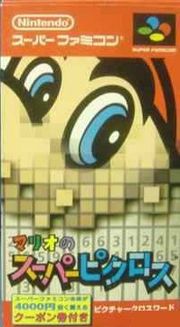- Mario's Super Picross
-
Mario's Super Picross 
Developer(s) Ape, Jupiter Publisher(s) Nintendo Platform(s) Super Famicom
Virtual ConsoleRelease date(s) Super Famicom
JP September 14, 1995
Virtual Console
JP December 19, 2006
PAL September 14, 2007Genre(s) Puzzle Mode(s) Single player Rating(s) - PEGI: 3+
Media/distribution Cartridge Mario's Super Picross (マリオのスーパーピクロス Mario no Sūpā Pikurosu) is a Super Famicom sequel to Mario's Picross. It is erroneously named as Mario's Picross 2, which is actually the name of the Game Boy sequel to Mario's Picross. The game is compatible with the Super Famicom Mouse.
After the failure of Mario's Picross in North America, Nintendo decided not to release this game in that region and instead only in Japan. It was later re-released for download on the Wii's Virtual Console service on December 19, 2006 in Japan. In PAL territories it was released on September 14, 2007, the 12th anniversary of the game's original Japanese release, marking the first Western release of the game. It carries a price of 900 Wii Points, 100 more than a normal Super Famicom/SNES game. The Western Virtual Console release has been left nontranslated, with original Japanese text intact.[1] The game has yet to make an appearance on the North American Virtual Console after being released nearly four years ago in Europe despite the fact the Game Boy version is available in all regions from the Nintendo 3DS' eShop.
Contents
Gameplay
Gameplay remains the same as in Mario's Picross, where the player must decipher the picture in each level, progressing to harder and harder puzzles. However, the player may also play "as" Wario, who presents a different challenge due to changes in the gameplay.
Each game is played against the clock. Opposing the picross tradition of black and white squares, the puzzles are set in stone and are picked out by Mario with a pick-axe type tool. The initial levels are smaller and a lot easier and are mainly Japanese symbols and Greek letters. When the player solves a puzzle correctly, the black-and-white representation becomes colored and animated, and the game shows the player the title of the puzzle. When the player finishes a section, Mario will congratulate him on his progress and either bow (in the first and last levels) or give a thumbs up (in all other levels).
The player must work through levels in order to get access to harder levels, with more rows and columns. In Mario's puzzles, if the player marks the wrong cell, time will be lost. The amount of time lost doubles for every mistake (one minute, two minutes, four, and finally eight). In Wario's puzzles, the time counts up from zero, and you are not penalized for marking the incorrect cell. However, you are also not told you made a mistake, and thus the mark will stay until you remove it. Because of this, Wario's puzzles are a little harder than Mario's puzzles, as it takes more guesswork to solve them. This mode is similar to the Free Mode in Picross DS.
Legacy
Nintendo re-used the game engine in their Picross NP series. In the Picross NP series, players could decipher pictures of Pokémon, Star Fox and other game characters, as well as famous locations in Japan.
Some of the puzzles in Mario's Super Picross may be made available to download via Nintendo Wi-Fi Connection to the game Picross DS. As of January 3, 2008, there are nine packs.
References
External links
Mario puzzle games Dr. Mario Mario's Picross Mario's Picross • Mario's Super PicrossOther Categories:- 1995 video games
- Jupiter (company) games
- Mario Bros. games
- Mario Universe games
- Nonograms
- Super Nintendo Entertainment System games
- Virtual Console games
Wikimedia Foundation. 2010.
